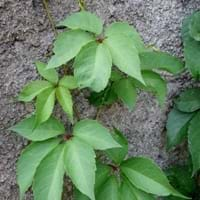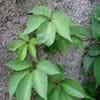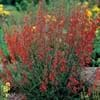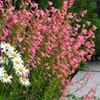Life Span
Perennial
Perennial
Origin
Central North America, Eastern Mexico, Eastern North America, Eastern United States, Southeastern Canada
China
Types
Not Available
Actinidia deliciosa chlorocarpa, Actinidia deliciosa deliciosa
Number of Varieties
Not Available
Habitat
Brushlands, Chaparral, open Woodlands, Riverbanks, shaded woods, Stream side
Mountain forests
USDA Hardiness Zone
7-8
6-9
AHS Heat Zone
Not Available
9-7
Sunset Zone
Not Available
4, 5, 6, 7, 8, 9, 12, 14, 15, 16, 17, 18, 19, 20, 21, 22, 23, 24
Habit
Spreading
Vining/Climbing
Minimum Width
Not Available
Flower Color
Not Available
Light Yellow, Ivory
Flower Color Modifier
Bicolor
Bicolor
Fruit Color
Black, Blue
Tan, Brown
Leaf Color in Spring
Green, Purplish Green
Green, Light Green
Leaf Color in Summer
Gray Green
Green
Leaf Color in Fall
Blue Green
Light Green, Yellow green
Leaf Color in Winter
Gray Green
Light Green
Leaf Shape
Palmate
Heart-shaped
Plant Season
Late Summer
Spring, Summer, Fall
Sunlight
Full Shade, Partial shade, Partial Sun
Full Sun, Partial Sun
Type of Soil
Loam, Sandy
Clay, Loam
The pH of Soil
Neutral, Slightly Acidic, Slightly Alkaline
Acidic, Neutral
Soil Drainage
Well drained
Average
Bloom Time
Late Summer, Summer
Late Spring, Early Summer
Tolerances
Drought
Drought
Where to Plant?
Ground
Ground
How to Plant?
Seedlings
Layering, Softwood cuttings
Plant Maintenance
Low
Medium
Watering Requirements
Needs less watering
Water daily during growing season
In Summer
Moderate
Lots of watering
In Spring
Moderate
Moderate
In Winter
Ample Water
Average Water
Soil pH
Neutral, Slightly Acidic, Slightly Alkaline
Acidic, Neutral
Soil Type
Loamy, Moist, Sandy
Clay, Loam
Soil Drainage Capacity
Well drained
Average
Sun Exposure
Full Shade, Partial shade, Partial Sun
Full Sun, Partial Sun
Pruning
Prune after flowering, Prune for shortening long shoots, Prune in late summer or fall
Prune for shortening long shoots, Prune in early summer, Prune in late winter
Fertilizers
Fertilize every year
Self-fertile
Pests and Diseases
Aphids, Black Vine Weevil, Caterpillars, Flea Beetles, Leaf eating pests, Leaf Hoppers, Scale
Armillaria root rot, Armored scales, Bleeding canker, Botrytis Blight, Crown gall, Nematodes, Phytophthora Root Rot, Red blotch
Plant Tolerance
Drought
Drought
Flower Petal Number
Single
Single
Foliage Texture
Fine
Medium
Foliage Sheen
Matte
Matte
Attracts
Birds
Not Available
Allergy
Abdominal pain, Bloody vomiting, Diarrhea, dilation of pupils, drowsiness, Headache, Nausea, Skin irritation, Sweating, Toxic, Twitching of face, Weak pulse
Inflammation, Mouth itching, Throat itching
Aesthetic Uses
Showy Purposes, Used for decorating walls, fences, gates, hedges, etc.
Not Used For Aesthetic Purpose
Beauty Benefits
No Beauty Benefits
Beautiful Skin, Protects from sun damage
Environmental Uses
Air purification, Food for animals, Food for birds
Air purification
Medicinal Uses
Antirheumatic, Cough, Diarrhea, Expectorant
constipation, Heart problems, Low Blood Pressure
Part of Plant Used
Bark, Fruits, Root, Sap
Fruits
Other Uses
Used as Ornamental plant, Used in herbal medicines
Used As Food, Used for its medicinal properties
Used As Indoor Plant
No
No
Used As Outdoor Plant
Yes
Yes
Garden Design
Vine, Wall
Edible, Fruit / Fruit Tree, Rock Garden / Wall, Vine
Botanical Name
Parthenocissus quinquefolia
ACTINIDIA deliciosa
Common Name
Virginia creeper, Victoria creeper, five-leaved ivy, or five-finger
Chinese Gooseberry, Fuzzy Kiwi, Kiwi
In Hindi
वर्जीनिया लता
कीवी फल
In German
Selbstkletternde Jungfernrebe, Wilder Wein
Kiwi, Chinesischer Strahlengriffel
In French
vigne vierge vraie, vigne vierge à cinq folioles, vigne vierge de Virginie
Kiwi, Groseille de Chine, Yang Tao, Souris végétale
In Spanish
Parra Virgen, Viña virgen y Enredadera de Virginia
kiwi, kivi, actinidia
In Greek
αναρριχητικό φυτό της Βιρτζίνια
Ακτινίδια
In Portuguese
Virginia Creeper
Quiuí
In Polish
winobluszcz
Owoc kiwi
In Latin
Virginia creeper
Kiwi fructum
Phylum
Magnoliophyta
Magnoliophyta
Class
Magnoliopsida
Magnoliopsida
Family
Vitaceae
Actinidiaceae
Genus
Parthenocissus
Actinidia
Clade
Angiosperms, Eudicots, Rosids
Angiosperms, Asterids, Eudicots
Tribe
Not Available
Not Available
Subfamily
Not Available
Not Available
Number of Species
Not Available
Importance of Virginia Creeper and Kiwifruit
Want to have the most appropriate plant for your garden? You might want to know the importance of Virginia Creeper and Kiwifruit. Basically, these two plants vary in many aspects. Compare Virginia Creeper and Kiwifruit as they differ in many characteristics such as their life, care, benefits, facts, etc. Every gardener must at least have the slightest clue about the plants he wants to plant in his garden. Compare their benefits, which differ in many ways like facts and uses. The medicinal use of Virginia Creeper is Antirheumatic, Cough, Diarrhea and Expectorant whereas of Kiwifruit is constipation, Heart problems and Low Blood Pressure. Virginia Creeper has beauty benefits as follows: No Beauty Benefits while Kiwifruit has beauty benefits as follows: No Beauty Benefits.
Compare Facts of Virginia Creeper vs Kiwifruit
How to choose the best garden plant for your garden depending upon its facts? Here garden plant comparison will help you to solve this query. Compare the facts of Virginia Creeper vs Kiwifruit and know which one to choose. As garden plants have benefits and other uses, allergy is also a major drawback of plants for some people. Allergic reactions of Virginia Creeper are Abdominal pain, Bloody vomiting, Diarrhea, dilation of pupils, drowsiness, Headache, Nausea, Skin irritation, Sweating, Toxic, Twitching of face and Weak pulse whereas of Kiwifruit have Inflammation, Mouth itching and Throat itching respectively. Having a fruit bearing plant in your garden can be a plus point of your garden. Virginia Creeper has no showy fruits and Kiwifruit has no showy fruits. Also Virginia Creeper is flowering and Kiwifruit is not flowering . You can compare Virginia Creeper and Kiwifruit facts and facts of other plants too.





